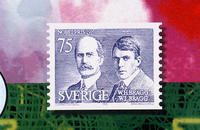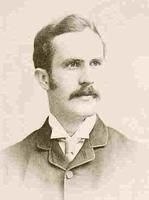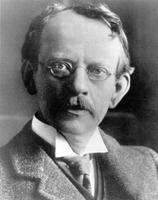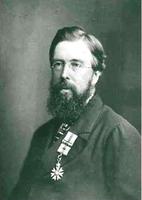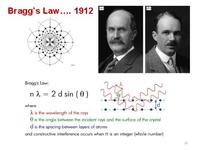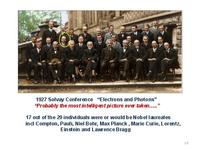
South Australian Medical Heritage Society Inc
Website for the Virtual Museum
Home
Coming meetings
Past meetings
About the Society
Main Galleries
Medicine
Surgery
Anaesthesia
X-rays
Hospitals,other
organisations
Individuals of
note
Small Galleries
Ethnic medicine
- Aboriginal
- Chinese
- Mediterran
The Braggs: X-Ray Crystallography and a Nobel Centenary to Celebrate
Acknowledgements:
We are most grateful to Mr Robert George, who talked to us about the Braggs, their Nobel Prize
and achievements. Robert George is diagnostic radiographer, a past president of the International
Society of Radiographers and Radiological Technologists (ISRRT), a life member of the Australian
Institute of Radiology, and member of several Advisory Committees.
He has been a mentor to many in his profession, and his children followed in the same profession.
His presentation is well illustrated and contains a rare photograph of a group of 29 scientists taken at conference in 1927, 17 of those present became Nobel Laureates.
"Standing on the shoulders of giants"
The Braggs: X-Ray Crystallography and a Nobel Centenary to Celebrate.
We read daily of recent medical advances related to our increasing knowledge of our genes. Both Prostate and Breast cancer are now better differentiated and subsequently treated by our ability to determine subgroups depending on the genetic make-up of these diseases. This knowledge did not come easily and depended on the work of many scientists over the past decades.
One of the early discoveries which had a profound influence on this work was the subject of a memorable celebration in November 2015 – the Centenary of the Nobel Prize for Physics, awarded in 1915 to William and Lawrence Bragg, the father and son who won fame for their work on X-ray Crystallography.
This Centenary coincided almost to the week with the 120th Anniversary of the discovery of X-Rays by Röntgen.
William Henry Bragg was born on a farm in Cumbria in the United Kingdom, entering Trinity College, Cambridge in 1881 as a shy 19 year old. His Professor at the Cavendish Laboratory, J. J. Thompson, had suggested Bragg apply for Professor of Physics at the University of Adelaide in South Australia, and he was appointed in 1886.
On his arrival Bragg met Charles Todd, the Postmaster General and Government Astronomer, who had overseen the construction of the Overland Telegraph from Darwin to Adelaide through the centre of Australia. When news of Röntgen's discovery of X-rays in November 1895 spread around the world, it reached Adelaide via Todd's Overland Telegraph. Bragg, who had married Todd's daughter, heard of Röntgen's discovery from his father-in-law and immediately replicated Röntgen's experiments, enthusiastically embracing this new and exciting field of "x-ray science".
Bragg became a celebrity in Adelaide, holding public lectures and demonstrations of the wonders
of X-rays, even taking a radiograph of his 6 year old son's elbow in early 1896 when young
Lawrence Bragg fell off his bicycle – Lawrence later recalled the occasion ...
"I must have been one of the first patients to be X-rayed in South Australia ... my father set up a tube worked by an induction coil, and he took radiographs of the broken elbow ... I was scared stiff by the fizzing sparks and smell of ozone"
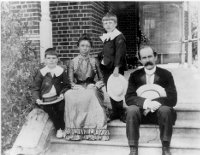
From Left – Lawrence, Gwendoline, Robert and William
William's elder son Lawrence later joined his father in the Physics department at Adelaide University, and in the early 1900's both Braggs studied the characteristics of X-rays and Alpha rays, and in particular their absorption and diffraction through matter. William Bragg's early work led to the discovery of the "Bragg Peak", plotting the rapid fall off of radiation as protons were absorbed in tissue – used today as the basis of Proton Therapy. Proton therapy now enables organs adjacent to tumours to be spared the high doses the tumour receives. For this work he was nominated for Fellowship of the Royal Society by outstanding scientists including J. J. Thompson and Ernest Rutherford.
To further their careers, the Bragg family returned to England in 1909, where William took up the Physics Chair at Leeds University. Lawrence studied at The Cavendish and they continued their joint research on X-ray Crystallography in 1912-3, following on from the work on X-ray diffraction by von Laue. Lawrence developed a ground-breaking scientific explanation of Laue's work – first presented to the Cambridge Philosophical Society on 11th November 1912, and their work on X-ray Crystallography, including the Bragg equation or Bragg's law, attracted much interest. The joint work was presented at the prestigious 1913 Solvay Conference in the Conference theme "The Structure of Matter" alongside J. J. Thompson and von Laue. Following the Conference, they were sent messages of congratulations from Marie Curie, Einstein, Rutherford and Laue.
Their work was interrupted by the outbreak of the First World War, which saw both Lawrence and his younger brother Robert enlist to serve their country, and William re-focus into sonar research. Lawrence Bragg had an outstanding military career on the Front Line of the Western Front using his science background in the development of sound ranging techniques to locate enemy artillery. He was awarded the Military Cross and mentioned in dispatches 3 times.
In 1915, in the midst of hostilities came news of the awarding of the Nobel Prize jointly to William and Lawrence "for their work in the analysis of crystal structure by means of x-rays". Laue had been recognised in 1914 for the initial discovery and the Braggs in 1915 for its application. Lawrence received the news from his father whilst on the Western Front, though this was tempered by the death in August 1915 of his younger brother Robert who had died at Gallipoli, serving with the British Army. This tragedy had a profound effect on the entire family and overshadowed William and Lawrence's great work.
Due to the hostilities, the 1915 Nobel awards were not presented until 1920 – the Bragg's chose not to attend the event, but Lawrence did attend in 1922 to accept the award and give an acceptance speech. He also attended the 50th Anniversary in 1965 and delivered the first Nobel Guest Lecture. Lawrence attended the 1927 Solvay Conference where he proudly stood with the likes of Marie Curie, Einstein, Rutherford, Neil Bohr, Max Planck, Lorenz and Langevin – a photograph of this group at the time was considered "the most intelligent picture ever taken" with 17 Nobel laureates among the 29 attendees.
Both William and Lawrence subsequently held Directorships of the prestigious Royal Institution, and William was also awarded the Order of Merit and the Presidency of the Royal Society from 1935-40. Lawrence was appointed head of the Cavendish in Cambridge in 1938, and served in that capacity until 1953.
Following the end of the 2nd World War he controversially changed the direction of research towards the study of biological molecules using x-rays. This supported a focus on Perutz and Kendrew and of course, Crick and Watson, whose work on the structure of DNA was underpinned by Rosalind Franklin's famous crystallographic image – photograph 51 – showing a double helix. All were Nobel Laureates in 1962 on Lawrence Bragg's watch. Indeed, noted molecular biologist Sir David Phillips is quoted as saying "... the X-ray method he (Bragg) had discovered forty years before was at the heart of a profound insight into the nature of life itself". Lawrence Bragg was subsequently awarded the prestigious Röntgen Plaque from the Röntgen Museum in Germany in 1955.
From the early days of X-rays and radiography 120 years ago, we have seen the development of
Molecular Imaging with its strong links to the work of the Braggs recognised by their
Nobel Prize a mere 100 years ago – a truly remarkable period of which we should be
very proud to have been a small part. The Braggs work is best summed up by Baroness Susan
Greenfield, the recent Director of the Royal Institution in London,
"The Braggs' contribution was the first step towards the mapping of the genome, molecular biology, and all the genetic modifications, for good or ill, that will characterise much of our lives, and much of those of our children and grandchildren in the 21st century".
Robert George FIR.,
References :-
- G.M. Caroe, "William Henry Bragg, 1862-1942, Man and Scientist", Cambridge University Press.
- John Jenkin, "William and Lawrence Bragg, Father and Son - the most extraordinary collaboration in Science", Oxford University Press.
- Baroness Susan Greenfield, "The Bragg Initiative - Bragg about Adelaide", SA Museum Exhibition Publication, 2005.
- G.K. Hunter, "Light is a messenger - the Life and Science of William Lawrence Bragg", Oxford University Press.
